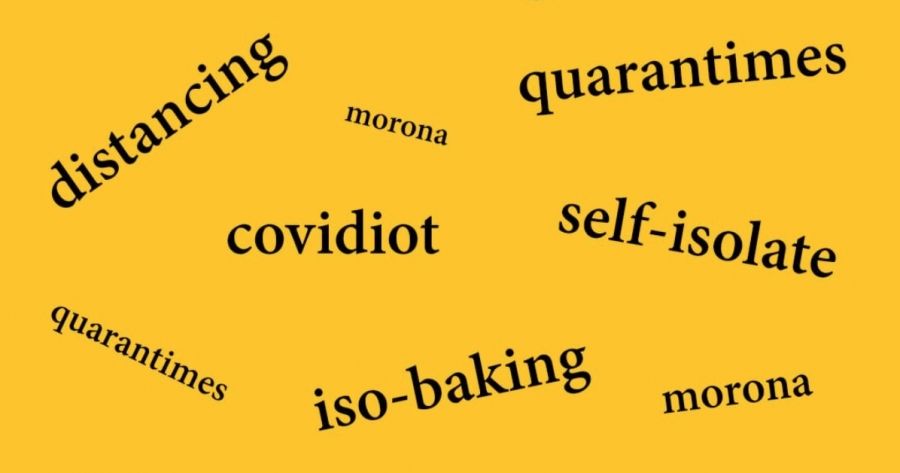
- Free Article: No
- Contents Category: Language
- Custom Article Title: Coronaspeak: Tracking language in a pandemic
- Review Article: No
- Custom Highlight Text:
The Covid-19 pandemic has affected all our lives, and little else has featured in the media for weeks. Unsurprisingly, this has led those of us who work with words to track the language of the pandemic (coronaspeak) closely. Here at the Australian National Dictionary Centre (temporarily WFH, of course), we have been compiling a database of the words emerging from the pandemic; from anti-lockdown protest to zumping (being dumped via Zoom), the Covid-19 isolation lockdown has generated its own vocabulary.
- Grid Image (300px * 250px):

The language generated by the pandemic and responses to it reflects different aspects of the experience. Most notably, perhaps, there is the technical, medical, and public health vocabulary with which many of us have become familiar, such as PPE, viral load, super spreader, cluster effect, community transmission, reproduction number, suppression phase, and, of course, flattening the curve.
Linguist Tony Thorne, who has been collecting examples of coronaspeak, talks about this as the ‘medicalisation’ of our everyday language. While it might seem that these terms are transparent, they can have complex histories and meanings. An example of this is social distancing, which has prompted some debate as to whether it is the right term to use: should we call it ‘social’ or in fact ‘physical’ distancing? The term social distancing has its origins in sociology and psychology, and is used in terms of one’s relationships to members of an outgroup; in this sense, it has nothing to do with keeping your physical distance.
The language of lockdown, quarantine (quazza), and isolation (iso) has also generated a range of words, mostly relating to what we are doing, eating, or drinking: for example, coronacuisine, driveway drinks, iso-baking (and various other ‘iso’ activities), quarantini, and zoombombing. Panic buying, which was such a phenomenon at the beginning of the shutdown, has led to panic buyer’s remorse as well as a variety of hashtags used on social media, mostly relating to the toilet-paper buying panic, such as #toiletpapergate.
Tony Thorne identifies several themes aside from the ones already mentioned. He notes a category of words that relate to ‘describing the new realities’ that includes such words as coronaverse, quarantimes, coronapocalypse, and coronanoia. Another category that Thorne identifies is words relating to the security/safety measures we are taking: these include elbump (for the elbow bump), coronadodge (swerving to avoid passers-by), and corona-shaming.
Slang terms have featured, as we try to adapt to yet another ‘new normal’. Some are mentioned above. Thorne has collected other amusing ones, including the rhyming slang Miley Cyrus (virus), doomscrolling (obsessively reading online news), coronacranky, and covidiot (a variant of this: morona).
The language of the coronavirus has been largely a global one, but some Australianisms also feature in the vocabulary of Covid-19: abbreviations such as iso, quazza, rona, and sanny/sanno (for sanitiser) have proven popular, and the coronavirus has even been dubbed the cozza. We have seen talk of yob-dobbing and ronadobbing, and discussions about how to restart the NRL saw mention of a possible NRL Island.
Yet while coronaspeak has been mostly globally shared, we have also seen localised attempts to mobilise language. Prime Minister Scott Morrison, in particular, has invoked the Anzac spirit and Team Australia as ways of trying to inspire the population to support control measures and restrictions. The Anzac spirit was recently evoked in the bushfires and attests to the ongoing importance of Anzac to our national identity and political rhetoric. Paul Daley, in a recent piece in the Guardian, cautioned against such an invocation of Anzac. Other countries have compared the pandemic to a war and have called for wartime spirit in combating it, but such language has its dangers. Team Australia, on the other hand, is a term of more recent vintage. It was popularised by Tony Abbott – the Australian National Dictionary Centre had it on the 2014 Australian Word of the Year shortlist – and has a likely origin in sport. It is perhaps not surprising that the prime minister, a sports fan, would invoke this term. It remains one worth watching closely, because it is clearly important to the way our politicians are engaging with, and attempting to shape, ideas of national identity.
What factors have helped coronaspeak evolve? Obviously, some terms are descriptive of features of the pandemic, but we can see with, for example, slang terms, that they not only serve to describe aspects of our experiences but also help us come to terms with them. Slang functions to make the unfamiliar familiar and manageable. We’ve seen in previous times of crisis – notably wartime – the way in which language helps us manage the new realities we face. Social media has also played a role in this pandemic; hashtags in particular have been an essential way in which we as a community can share our concerns and anxieties – and try to cheer each other.
Those of us interested in language will continue to monitor the language of the pandemic – as well as of the covexit – closely. It will no doubt continue to reveal something of our preoccupations and our anxieties.
Correction
An earlier version of this article referred to March 2019 instead of March 2020. The error has now been corrected.



Comments powered by CComment